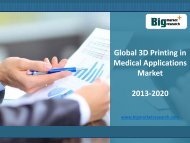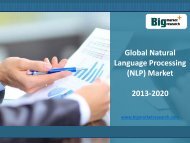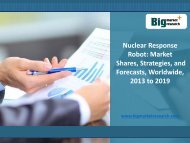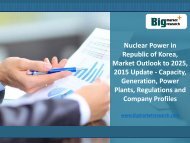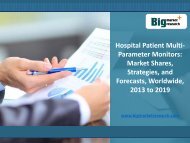PharmaPoint: HER2-Positive Breast Cancer Market, Global Drug Analysis to 2023
Big Market Research, Global PharmaPoint HER2-Positive Breast Cancer Drug Market Size, Share, Trends, Application, Forecast, Demand, Analysis, Research, Report, Opportunities, Segmentation, to 2023. Browse complete report & TOC @ http://www.bigmarketresearch.com/pharmapoint-her2-positive-breast-cancer-global-drug-forecast-and-analysis-to-2023-market HER2-positive breast cancer is the second most common cancer in the world and the most common cancer in women worldwide. This report focuses on the current treatment landscape, unmet needs, current pipeline, and commercial opportunities in the HER2-positive breast cancer market, with coverage of multiple settings of the disease including neoadjuvant, adjuvant, first-, second-, third-, and fourth-line metastatic. This report forecasts that the two monoclonal antibodies that also target the HER2 receptor will ensure Roche still occupies over 95% of the market in 2023. The challenge for new entrants into the HER2-positive market is to find patient populations that are currently underserved, and can work cooperatively with Roche’s targeted therapies. The HER2-positive breast cancer market will increase by 2.5-fold, reaching $12.63bn by 2023, at a CAGR of 9.82%, driven by the rapid uptake of the latest premium-priced biologics. By 2023, the largest market segment will be the adjuvant setting, with rapid growth at a CAGR of 12.3%, and representing 63% of the total HER2-positive market. Herceptin will no longer be the market leader, with new agents Perjeta and Kadcyla taking 37% and 39% market share respectively.
Big Market Research, Global PharmaPoint HER2-Positive Breast Cancer Drug Market Size, Share, Trends, Application, Forecast, Demand, Analysis, Research, Report, Opportunities, Segmentation, to 2023. Browse complete report & TOC @ http://www.bigmarketresearch.com/pharmapoint-her2-positive-breast-cancer-global-drug-forecast-and-analysis-to-2023-market
HER2-positive breast cancer is the second most common cancer in the world and the most common cancer in women worldwide. This report focuses on the current treatment landscape, unmet needs, current pipeline, and commercial opportunities in the HER2-positive breast cancer market, with coverage of multiple settings of the disease including neoadjuvant, adjuvant, first-, second-, third-, and fourth-line metastatic. This report forecasts that the two monoclonal antibodies that also target the HER2 receptor will ensure Roche still occupies over 95% of the market in 2023. The challenge for new entrants into the HER2-positive market is to find patient populations that are currently underserved, and can work cooperatively with Roche’s targeted therapies. The HER2-positive breast cancer market will increase by 2.5-fold, reaching $12.63bn by 2023, at a CAGR of 9.82%, driven by the rapid uptake of the latest premium-priced biologics.
By 2023, the largest market segment will be the adjuvant setting, with rapid growth at a CAGR of 12.3%, and representing 63% of the total HER2-positive market. Herceptin will no longer be the market leader, with new agents Perjeta and Kadcyla taking 37% and 39% market share respectively.
You also want an ePaper? Increase the reach of your titles
YUMPU automatically turns print PDFs into web optimized ePapers that Google loves.
<strong>PharmaPoint</strong>:<br />
<strong>HER2</strong>-<strong>Positive</strong> <strong>Breast</strong><br />
<strong>Cancer</strong> –<br />
<strong>Global</strong> <strong>Drug</strong> Forecast<br />
and <strong>Market</strong> <strong>Analysis</strong> <strong>to</strong><br />
<strong>2023</strong><br />
www.bigmarketresearch.com
Report Description<br />
Summary<br />
<strong>HER2</strong>-positive breast cancer is the second most common cancer in the world and the<br />
most common cancer in women worldwide. This report focuses on the current treatment<br />
landscape, unmet needs, current pipeline, and commercial opportunities in the <strong>HER2</strong>-<br />
positive breast cancer market, with coverage of multiple settings of the disease including<br />
neoadjuvant, adjuvant, first-, second-, third-, and fourth-line metastatic.<br />
Browse complete report @<br />
http://www.bigmarketresearch.com/pharmapoint-her2-positive-breast-cancer-globaldrug-forecast-and-analysis-<strong>to</strong>-<strong>2023</strong>-market
Report Description<br />
Since its introduction in 1998, Roche’s gold standard therapy, Herceptin (trastuzumab), a<br />
monoclonal antibody, revolutionized the treatment of the disease. The realization that<br />
targeting the <strong>HER2</strong> recep<strong>to</strong>r could significantly improve disease-free survival (DFS) has<br />
created a large market for <strong>HER2</strong>-directed therapies. In 2013, Roche dominated the <strong>HER2</strong>-<br />
positive market, with a share of 95%. With Herceptin’s patent expiry looming in Europe<br />
Roche launched Perjeta and Kadcyla in 2012 and 2013 <strong>to</strong> maintain its leadership.<br />
<strong>Global</strong>Data forecasts that the two monoclonal antibodies that also target the <strong>HER2</strong><br />
recep<strong>to</strong>r will ensure Roche still occupies over 95% of the market in <strong>2023</strong>.<br />
The challenge for new entrants in<strong>to</strong> the <strong>HER2</strong>-positive market is <strong>to</strong> find patient<br />
populations that are currently underserved, and can work cooperatively with Roche’s<br />
targeted therapies. The <strong>HER2</strong>-positive pipeline is weak, and there are still unmet needs<br />
that have yet <strong>to</strong> be suitably addressed.<br />
Feel free <strong>to</strong> enquire about this report @<br />
http://www.bigmarketresearch.com/report-enquiry/191126
Report Description<br />
Key Questions Answered<br />
• What are the R&D strategies being used by drug makers?<br />
• How is the disease management evolving.What impact for drug manufacturers?<br />
• What opportunities remain for future players?<br />
• How large are the neoadjuvant, adjuvant, and metastatic markets for <strong>HER2</strong> targeting<br />
agents, and which one is growing the fastest?<br />
• What exciting, innovative approaches are being investigated in <strong>HER2</strong>-positive breast<br />
cancer?<br />
• What <strong>to</strong> KOLs think about the latest therapies and drug development strategies?<br />
Need Discount? Request here @<br />
http://www.bigmarketresearch.com/purchase-enquiry/191126
Table of Contents<br />
1.1 List of Tables<br />
1.2 List of Figures<br />
2 Introduction<br />
2.1 Catalyst<br />
2.2 Related Reports<br />
2.3 Upcoming Related Reports<br />
3 Disease Overview<br />
3.1 Etiology and Pathophysiology<br />
3.1.1 Etiology<br />
3.1.2 Pathophysiology<br />
3.2 Basic <strong>Breast</strong> Ana<strong>to</strong>my<br />
3.3 <strong>Breast</strong> <strong>Cancer</strong> Staging<br />
3.4 Prognosis<br />
3.5 Quality of Life<br />
3.6 Symp<strong>to</strong>ms
Table of Contents<br />
4 Epidemiology<br />
4.1 Disease Background<br />
4.2 Risk Fac<strong>to</strong>rs and Comorbidities<br />
4.2.1 A family his<strong>to</strong>ry of breast cancer and BRCA1/2 gene mutations significantly increase<br />
the breast cancer risk<br />
4.2.2 Reproductive hormonal fac<strong>to</strong>rs influence the risk of breast cancer<br />
4.2.3 Modifiable lifestyle-related fac<strong>to</strong>rs increase the risk of mortality in breast cancer<br />
patients<br />
4.2.4 Screening programs have been shown <strong>to</strong> reduce breast cancer mortality, although<br />
the benefits need <strong>to</strong> be carefully weighed against the risks<br />
4.3 <strong>Global</strong> Trends<br />
4.3.1 Incidence<br />
4.3.2 Prevalence and Survival<br />
4.4 Forecast Methodology<br />
4.4.1 Sources Used<br />
4.4.2 Sources Not Used
Report Description<br />
Key Findings<br />
• The <strong>HER2</strong>-positive breast cancer market will increase by 2.5-fold, reaching $12.63bn<br />
by <strong>2023</strong>, at a CAGR of 9.82%, driven by the rapid uptake of the latest premium-priced<br />
biologics. Approval of these agents in the early (non-metastatic) stages will have the<br />
greatest impact on the market, along with combinations of branded therapies.<br />
• By <strong>2023</strong>, the largest market segment will be the adjuvant setting, with rapid growth at<br />
a CAGR of 12.3%, and representing 63% of the <strong>to</strong>tal <strong>HER2</strong>-positive market. Herceptin<br />
will no longer be the market leader, with new agents Perjeta and Kadcyla taking 37%<br />
and 39% market share respectively.<br />
• The patent expiry of Herceptin in the 5EU in 2014, and in the US in 2019, will<br />
significantly reduce Herceptin sales, however, its introduction of a more convenient<br />
subcutaneous reformulation of Herceptin will limit this impact.
Report Description<br />
Key Findings<br />
• Development of new <strong>HER2</strong>-targeting therapies is slow, with only one agent, Puma<br />
Biotechnology’s neratinib, in Phase III, following the failure of BI’s gilotrif. The recent<br />
failure of GSK’s Tykerb in the adjuvant setting shows that TKIs are best suited <strong>to</strong> later<br />
stages of metastatic disease.<br />
• Entry in<strong>to</strong> the Roche-dominated <strong>HER2</strong>-positive market is challenging, with new players<br />
needing <strong>to</strong> find alternative MOAs in underserved patient populations. KOLs identified<br />
areas of important unmet need that can still provide opportunities in the <strong>HER2</strong>-<br />
positive space.<br />
• Future drug development will begin <strong>to</strong> merge the <strong>HER2</strong>-positive and <strong>HER2</strong>-negative<br />
populations, as new targets and MOAs are developed, providing exciting<br />
opportunities.
Report Description<br />
Scope<br />
• Overview of <strong>HER2</strong>-positive breast cancer, including epidemiology, etiology,<br />
pathophysiology, symp<strong>to</strong>ms, diagnosis, and disease management.<br />
• Annualized <strong>HER2</strong>-positive breast cancer therapeutics market revenue, annual cost of<br />
therapy, and treatment usage patterns in six patient segments (including neoadjuvant<br />
and adjuvant), forecast from 2013 <strong>to</strong> <strong>2023</strong>.<br />
• Key <strong>to</strong>pics covered include strategic competi<strong>to</strong>r assessment, market characterization,<br />
unmet needs, R&D strategies, and clinical trial design for the <strong>HER2</strong>-positive breast<br />
cancer therapeutics market
Report Description<br />
Scope<br />
• Pipeline analysis: comprehensive data assessing emerging trends and mechanisms of<br />
action under development for different lines of therapy. The most promising<br />
candidate in Phase III development is profiled.<br />
• <strong>Analysis</strong> of the current and future market competition in the global <strong>HER2</strong>-positive<br />
breast cancer therapeutics market. Insightful review of the key industry drivers,<br />
restraints and challenges. Each trend is independently researched <strong>to</strong> provide<br />
qualitative analysis of its implications.
Report Description<br />
Reasons <strong>to</strong> buy<br />
• Develop and design your in-licensing and out-licensing strategies through a review of<br />
pipeline products and technologies, and by identifying the companies with the most<br />
robust pipeline.<br />
• Develop business strategies by understanding the trends shaping and driving the<br />
global <strong>HER2</strong>-positive breast cancer therapeutics market.<br />
• Drive revenues by understanding the key trends, innovative products and<br />
technologies, market segments, and companies likely <strong>to</strong> impact the global <strong>HER2</strong>-<br />
positive breast cancer therapeutics market in the future.
Report Description<br />
Reasons <strong>to</strong> buy<br />
• Formulate effective sales and marketing strategies by understanding the competitive<br />
landscape and by analysing the performance of various competi<strong>to</strong>rs.<br />
• Identify emerging players with potentially strong product portfolios and create<br />
effective counter-strategies <strong>to</strong> gain a competitive advantage.<br />
• Organize your sales and marketing efforts by identifying the market categories and<br />
segments that present maximum opportunities for consolidations, investments and<br />
strategic partnerships.
FOR MORE DETAILS<br />
Visit us at :<br />
http://www.bigmarketresearch.com/pharmapoint-her2-<br />
positive-breast-cancer-global-drug-forecast-and-analysis-<strong>to</strong>-<br />
<strong>2023</strong>-market<br />
Stay With Us:<br />
TELEPHONE: +1 (855) 711-1555<br />
E-MAIL: help@bigmarketresearch.com<br />
5933 NE Win Sivers Drive,<br />
#205, Portland, OR 97220<br />
United States





